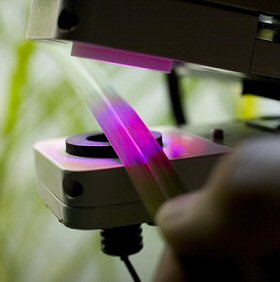12 November 2007
Evolutionary Algorithms Used To Design A Better Leaf
by Kate Melville

A computer model of a plant that mimics the process of evolution produces more leaves and fruit without needing extra fertilizer. The University of Illinois researchers who designed the in silico plant say that theirs is the first computer model to simulate every step of the photosynthetic process.
Researcher Steve Long said that the research team wanted to find out if they could "do better" than the plant in terms of productivity. Because of the complexity of photosynthesis, the researchers opted to build a computer model rather than experiment with actual plants.
Reporting on the work in Plant Physiology, Long explained that the researchers first had to build a reliable model of photosynthesis, one that would accurately mimic the photosynthetic response to changes in the environment. After determining the relative abundance of each of the proteins involved in photosynthesis, the researchers created a series of linked differential equations, each mimicking a single photosynthetic step. The team tested and adjusted the model until it successfully predicted the outcome of experiments conducted on real leaves, including their dynamic response to environmental variation.
The team then programmed the model to randomly alter levels of individual enzymes in the photosynthetic process. In many crop plants, most of the nitrogen taken in goes into the photosynthetic proteins of its leaves. Knowing that it was undesirable to add more nitrogen to the plants, the researchers asked a simple question: "Can we do a better job than the plant in the way this fixed amount of nitrogen is invested in the different photosynthetic proteins?"
Using evolutionary algorithms the model hunted for enzymes that - if increased - would enhance plant productivity. If higher concentrations of an enzyme relative to others improved photosynthetic efficiency, the model used the results of that experiment as a parent for the next generation of tests.
The researchers thus identified several proteins that could, if present in higher concentrations relative to others, greatly enhance the productivity of the plant. The new findings are consistent with results from other researchers, who found that increases in one of these proteins in transgenic plants increased productivity. "By rearranging the investment of nitrogen, we could almost double efficiency," Long said.
So, why haven't plants already evolved to be as efficient as possible? "The answer may lie in the fact that evolution selects for survival and fecundity, while we were selecting for increased productivity," Long mused. So while the changes suggested in the model might undermine the survival of a plant living in the wild, they should keep the plant viable in the farmer's field.
Related articles:
Chemists Take Step Toward Artificial Photosynthesis
Quantum Shenanigans Of Photosynthesis Mapped
Source: University of Illinois
Pic courtesy Don Hamerman
